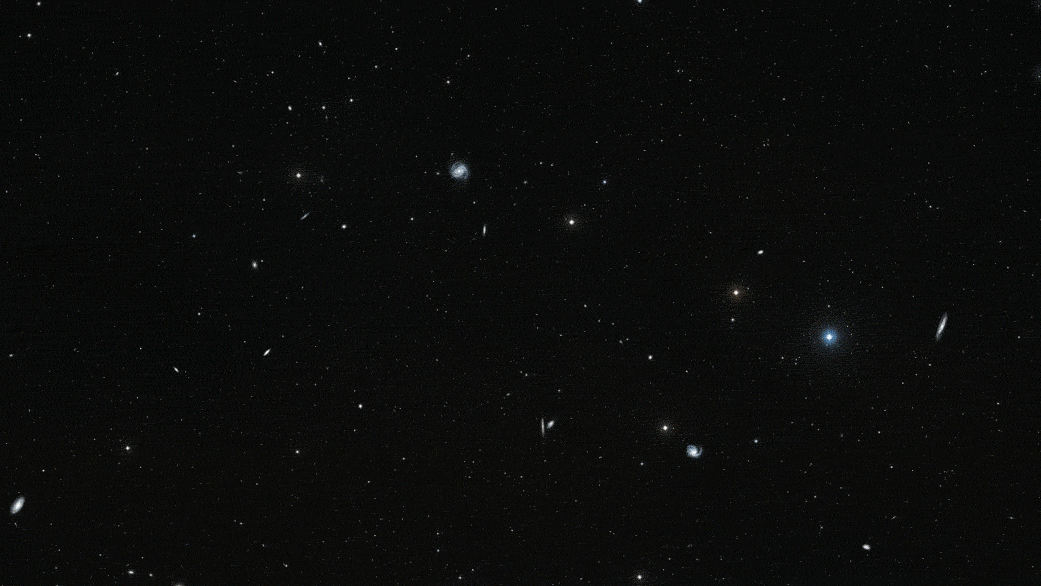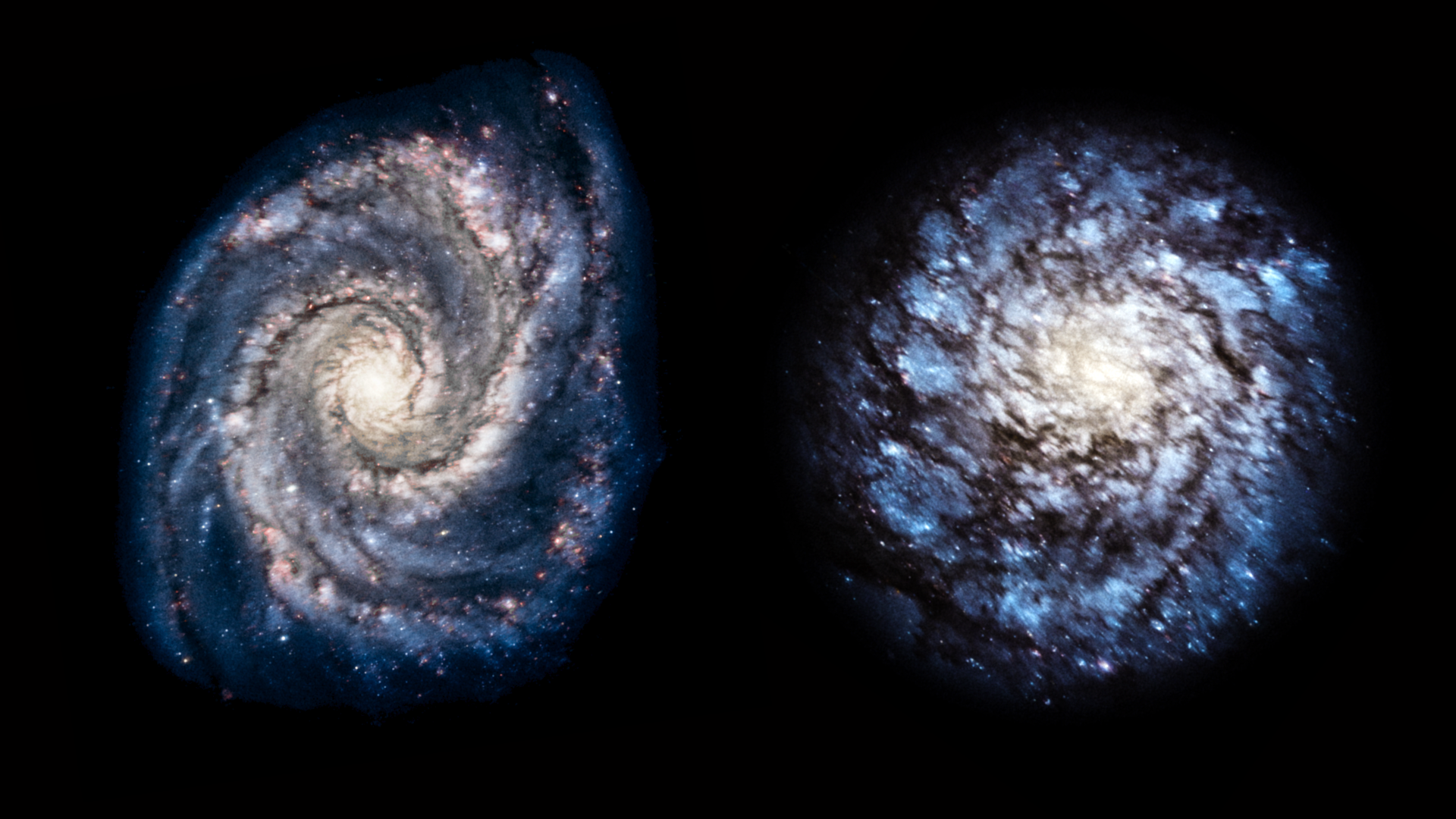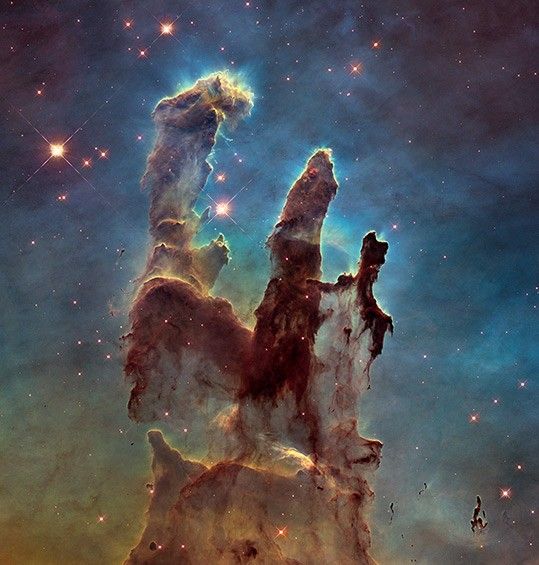In celebration of the 27th anniversary of the launch of NASA's Hubble Space Telescope on April 24, 1990, astronomers used the legendary telescope to take a portrait of a stunning pair of spiral galaxies. This starry pair offers a glimpse of what our Milky Way galaxy would look like to an outside observer.
The edge-on galaxy is called NGC 4302, and the tilted galaxy is NGC 4298. These galaxies look quite different because we see them angled at different positions on the sky. They are actually very similar in terms of their structure and contents.
From our view on Earth, researchers report an inclination of 90 degrees for NGC 4302, which is exactly edge on. NGC 4298 is tilted 70 degrees.
In NGC 4298, the telltale, pinwheel-like structure is visible, but it's not as prominent as in some other spiral galaxies. In the edge-on NGC 4302, dust in the disk is silhouetted against rich lanes of stars. Absorption by dust makes the galaxy appear darker and redder than its companion. A large blue patch appears to be a giant region of recent star formation.

Both galaxies are approximately 55 million light-years away. They reside in the constellation Coma Berenices in the Virgo Cluster of nearly 2,000 galaxies. Both were discovered in 1784 by astronomer William Herschel. Such objects were first simply called "spiral nebulas," because it wasn't known how far away they were. In the early 20th century, Edwin Hubble discovered that galaxies are other island cities of stars far outside our Milky Way.
A typical spiral galaxy has arms of young stars that wind outward from its center. The bright arms are regions of intense star formation. Such galaxies have a central bulge and are surrounded by a faint halo of stars. Many spiral galaxies also have bars that extend from the central bulge to the arms.
The edge-on NGC 4302 is about 87,000 light-years in diameter, which is about 60 percent the size of the Milky Way. It is about 110 billion solar masses, approximately one-tenth of the Milky Way's mass.
The tilted NGC 4298 is about 45,000 light-years in diameter, about one third the size of the Milky Way. At 17 billion solar masses, it is less than 2 percent of the Milky Way galaxy's 1 trillion solar masses.
The Hubble observations were taken between January 2 and January 22, 2017 with the Wide Field Camera 3 (WFC3) instrument in three visible light bands.
The Hubble Space Telescope was launched aboard the Space Shuttle Discovery on April 24, 1990 and deployed into low-Earth orbit the next day. From its perch high above the distorting effects of Earth's atmosphere, Hubble observes the universe in near-ultraviolet, visible, and near-infrared light. Over the past 27 years, the space telescope's breakthrough discoveries have revolutionized the fields of astronomy and astrophysics.
Hubble Trivia 2017
Launched on April 24, 1990, NASA's Hubble Space Telescope has made more than 1.3 million observations of more than 42,000 celestial objects.
- In its 27-year lifetime the telescope has made nearly 148,000 trips around our planet. Hubble has racked up plenty of frequent-flier miles, about 3.8 billion.
- An average of approximately 2 terabytes of Hubble data are added to the archive every month.
- Hubble observations have produced more than 141 terabytes of data, which will be available for present and future generations of researchers.
- Astronomers using Hubble data have published more than 14,600 scientific papers.
HUBBLE HIGHLIGHTS An Accelerating Universe
By capturing the glow from distant exploding stars, Hubble showed that the universe is expanding at an ever-faster rate. The acceleration may be caused by a mysterious "dark energy" that pervades the universe. Dark energy is a sort of "antigravity" that is pushing galaxies apart. Physicists regard dark energy as a total mystery, even though it comprises about 70 percent of the universe's mass/energy budget. The researchers who made the Hubble discovery of the accelerating universe were awarded the 2011 Nobel Prize in Physics. By observing how dark energy behaves over time, astronomers hope to gain a better understanding of what it is and how it might affect the future of the universe.
How Fast Is the Universe Expanding?
Nearly a century ago, Edwin Hubble measured the expansion rate of the universe from its origin in the big bang. This value, called the Hubble constant, is an essential ingredient needed to determine the age, size, and fate of the universe. Astronomers using Hubble have refined their measurements of the universe's current expansion rate to an uncertainty of just 2.4 percent — and are working to make it even more precise. The current value yields an age for the universe of 13.8 billion years old. Before Hubble was launched, the value for the Hubble constant was highly uncertain, and the calculations for the universe's age ranged from 10 billion to 20 billion years.
- See feature article at https://science.nasa.gov/mission/hubble/science/science-highlights/discovering-a-runaway-universe/.
Tracing the Growth of Galaxies
Before Hubble's launch, there was plenty of room for conjecture and theoretical modeling about how galaxies must evolve if the universe was born in the big bang. Ground-based observations were not able to establish which of several competing theories best described how galaxies formed and evolved in the early universe.
Hubble's powerful ability to detect galaxies that are much farther away than those ever seen before is allowing astronomers to trace the history of the universe. The deeper Hubble peers into space, the farther back in time it looks. The farthest galaxies detected by Hubble were forming just a few hundred million years after the big bang. Hubble's visible "core sample" of the universe shows galaxies during their youth, providing evidence that galaxies grew over time through mergers with other galaxies to become the giant galaxies we see today. Young galaxies have close encounters that sometimes ended in grand mergers that yield overflowing sites of new star birth as the colliding galaxies morph into wondrous new shapes. The early galaxies spied by Hubble are smaller and more irregularly shaped than today's grand spiral and elliptical galaxies. By studying galaxies at different epochs, astronomers can see how galaxies change over time. The process is analogous to a very large scrapbook of pictures documenting the lives of children from infancy to adulthood.
And the evolution continues. Hubble observations of our neighboring galaxy, M31, has allowed astronomers to predict with certainty that titanic collision between our Milky Way galaxy Andromeda will inevitably take place beginning 4 billion years from now. The galaxy is now 2.5 million light-years away, but it is inexorably falling toward the Milky Way under the mutual pull of gravity between the two galaxies and the invisible dark matter that surrounds them both. The merger will result in the creation of a giant elliptical galaxy.
- See feature article at https://www.nasa.gov/content/hubble-highlights-tracing-the-growth-of-galaxies.
Worlds Beyond Our Sun
At the time of Hubble's launch in 1990, astronomers had not found a single planet outside our solar system. Now there are more than 2,000 confirmed extrasolar planets, most of them discovered by NASA's Kepler space observatory and by ground-based telescopes. Hubble, however, has made some unique contributions to the planet hunt.
Astronomers used Hubble to make the first measurements of the atmospheric composition of extrasolar planets. The Hubble observations have identified atmospheres that contain sodium, oxygen, carbon, and hydrogen, and carbon dioxide, methane, and water vapor. The planets studied to date are too hot for life as we know it. But the Hubble observations demonstrate that the basic organic chemistry for life can be measured on planets orbiting other stars.
Hubble also made one of the first visible-light images of an extrasolar planet circling the southern star Fomalhaut, located 25 light-years away. The unusual planet is following a highly elongated orbit and is now just inside the disk's sharp inner edge, about 10 times the distance of Saturn from the sun.
- See feature article at https://www.nasa.gov/content/hubble-highlights-recognizing-worlds-beyond-our-sun.
Shining a Light on Dark Matter
Dark matter is an invisible form of matter that makes up most of the universe's mass and forms its underlying structure. Dark matter's gravity allows normal matter in the form of gas and dust to collect and build up into stars and galaxies. Although astronomers cannot see dark matter, they can detect its influence by observing how the gravity of massive galaxy clusters bends and distorts the light of more distant background galaxies, a phenomenon called gravitational lensing.
Using Hubble's sharp view, astronomers used the gravitational-lensing technique to construct the three-dimensional map by studying the warped images of half a million faraway galaxies. The new map provides the best evidence yet that normal matter, largely in the form of galaxies, accumulates along the densest concentrations of dark matter. The map stretches halfway back to the beginning of the universe and reveals a loose network of dark-matter filaments.
- See feature article at https://science.nasa.gov/missions/hubble/shining-a-light-on-dark-matter/.
Monster Black Holes Are Everywhere
Hubble provided decisive evidence that the hubs of most galaxies have mammoth black holes containing the mass of millions or even billions of stars. Not only are black holes residents in almost every galaxy, but they also have a tight relationship with their hosts. Hubble's census of more than 30 galaxies showed that a black hole's mass is dependent on the mass of its host galaxy's central bulge of stars. Large galaxies have black holes that are proportionally more massive. This close relationship may be evidence that black holes grew along with their galaxies, devouring a fraction of the galaxy's mass. The telescope also provided the first-ever views of disks of material encircling black holes.
- See feature article at https://www.nasa.gov/content/hubble-highlights-realizing-monster-black-holes-are-everywhere.
Uncovering Icy Objects in the Kuiper Belt
Probing the dwarf planet Pluto on the outskirts of our solar system, Hubble spied four new moons orbiting the icy world. Two of the moons are rotating chaotically as they orbit the dwarf planet.
Peering out even farther, to the dim, outer reaches of our solar system, Hubble uncovered Kuiper Belt objects that the New Horizons spacecraft could potentially visit on the outbound leg of its tour of the solar system. The New Horizons spacecraft swung by Pluto in 2015, making detailed observations of the frigid dwarf planet. Hubble played a critical role in helping astronomers prepare for the New Horizons mission. With frequent observations of Pluto from the early 1990s to 2010, astronomers continued to refine maps of the planet's surface. The maps were used as a guide for the July 2015 New Horizons flyby of the Pluto system.
- See feature article at https://www.nasa.gov/content/hubble-highlights-uncovering-icy-objects-in-the-kuiper-belt.
Studying the Outer Planets and Moons
Hubble witnessed impacts on Jupiter that were produced by minor bodies in the solar system. The latest collision occurred in 2009, when a suspected asteroid plunged into Jupiter's atmosphere, leaving a temporary dark feature the size of the Pacific Ocean. In 1994 Hubble watched 21 fragments of comet Shoemaker-Levy 9 bombard the giant planet sequentially, the first time astronomers witnessed such an event. Each impact left temporary black, sooty scars in Jupiter's planetary clouds.
Jupiter is well known for its Great Red Spot, a giant storm roughly the size of the Earth that has been visible since the early 1800s. Astronomers have also used Hubble to measure the Great Red Spot's downsizing. The mammoth storm has been shrinking in size for at least 80 years.
Jupiter's moons also have yielded important clues in the search for life beyond Earth. Hubble provided the best evidence yet for an underground saltwater ocean on Ganymede, the largest moon in the solar system. The subterranean ocean is thought to have more water than all the water on Earth's surface. Hubble also caught plumes of water vapor erupting off the surface of Jupiter's moon Europa. Astronomers do not yet know if these gas plumes are connected to subsurface liquid water. Identifying liquid water is crucial in the search for habitable worlds beyond Earth and for the search for life, as we know it.
Hubble also made the first images of bright aurorae at the northern and southern poles of Saturn and Jupiter. Aurorae are brilliant curtains of light in the upper atmosphere of Saturn and Jupiter. They develop when electrically charged particles trapped in the magnetic field surrounding the planet spiral inward at high energies toward the north and south magnetic poles. When these particles hit the upper atmosphere, they excite atoms and molecules there, causing them to glow (the same process occurring in street lights).
- See feature article at https://www.nasa.gov/content/hubble-highlights-studying-the-outer-planets-and-moons.
Evolution in the Asteroid Belt
Asteroids don't just slam into giant planets like Jupiter; they also collide with each other. Astronomers using Hubble witnessed one such smashup in the asteroid belt, a reservoir of leftover rubble from the construction of our solar system, located between Mars and Jupiter. The Hubble observations showed a bizarre X-shaped pattern of filamentary structures near the point-like core of the object and trailing streamers of dust. This complex structure suggests the small body is the product of a head-on collision between two asteroids traveling five times faster than a rifle bullet. Astronomers have long thought that the asteroid belt is being ground down through collisions, but such a smashup has never been seen before. Hubble also found evidence for asteroid disintegration.
Another Hubble observation of the asteroid belt revealed a unique object: an asteroid with six comet-like tails of dust radiating from it like spokes on a wheel. Unlike all other known asteroids, which appear simply as tiny points of light, this asteroid resembles a rotating lawn sprinkler. Astronomers were surprised with the asteroid's unusual appearance. Computer models of the object suggest that the tails could have been formed by a series of impulsive dust-ejection events.
- See feature article at https://www.nasa.gov/content/hubble-highlights-tracking-evolution-in-the-asteroid-belt.
Planet Construction Zones
Astronomers used Hubble to confirm that planets form in dust disks around stars. The telescope first resolved disks around nearly 200 stars in the nearby Orion Nebula. Looking at nearby stars, Hubble completed the largest and most sensitive visible-light imaging survey of dusty debris disks, which were probably created by collisions between leftover objects from planet formation. This survey yields insights into the birth of our own solar system. Hubble also spotted a mysterious gap in a vast protoplanetary disk of gas and dust swirling around TW Hydrae. The gap was most likely caused by a growing, unseen planet that is gravitationally sweeping up material and carving out a lane in the disk.
- See feature article at https://www.nasa.gov/content/hubble-highlights-finding-planetary-construction-zones.
The Birth of Stars
Hubble's vision penetrated gigantic, turbulent clouds of gas and dust where tens of thousands of stars are bursting to life. Hubble images reveal a bizarre landscape sculpted by radiation from young, exceptionally bright stars. The observations reveal that star birth is a violent process of intense radiation and shock fronts. The intense ultraviolet radiation clears out cavities in stellar nurseries and erodes material from giant gas pillars that are incubators for fledgling stars.
- See feature article at https://www.nasa.gov/content/hubble-highlights-exploring-the-birth-of-stars.
The Earth-orbiting observatory also has captured in unprecedented detail energetic jets of glowing gas from young stars. The jets are a byproduct of gas accretion around newly forming stars, and shoot off at supersonic speeds of about 100 miles per second in opposite directions through space. These phenomena are providing clues about the final stages of a star's birth, offering a peek at how our sun came into existence 4.5 billion years ago.
Going Out in a Blaze of Glory
Hubble revealed unprecedented details of the death of Sun-like stars. Ground-based images suggested that many of these objects, called planetary nebulae, had simple spherical shapes. Hubble showed, however, that their shapes are more complex. Some look like pinwheels, others like butterflies, and still others like hourglasses. The images yield insights into the complex hydrodynamics that accompany a star's shedding of its outer envelope before it collapses down to a white dwarf.
Turning its vision to the tattered remains of a massive star's explosive death, Hubble observations of Supernova 1987A revealed three mysterious rings of material encircling the doomed star. The telescope also spied brightened spots on the middle ring's inner region, caused by an expanding wave of material from the explosion slamming into it.
- See feature article at https://www.nasa.gov/content/hubble-highlights-documenting-the-death-throes-of-stars.


































